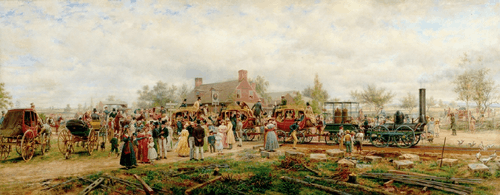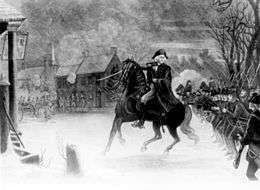Edward Lamson Henry

Edward Lamson Henry (January 12, 1841 – May 9, 1919), commonly known as E.L. Henry, was an American genre painter, born in Charleston, South Carolina.
Early life
Though born in Charleston, by age seven his parents had died and Henry moved to live with cousins in New York City. He began studying painting, there and at the Pennsylvania Academy of Fine Arts in Philadelphia. In 1860 he went to Paris, where he studied with Charles Gleyre and Gustave Courbet, at roughly the same time as Claude Monet, Pierre-Auguste Renoir, Frédéric Bazille, and Alfred Sisley.
In 1862, he returned to the United States, where he served as a clerk on a Union transport ship in the American Civil War. After the war he resumed his painting, with many works inspired by his experiences in the war. He moved into the prestigious Tenth Street Studio Building in Greenwich Village, where Winslow Homer also had a studio. In 1869, Henry was elected to the National Academy of Design, New York.[1]
Painting

As a painter of colonial and early American themes and incidents of rural life, he displays a quaint humor. Among his best-known compositions are some of early railroad travel, incidents of stage coach and canal boat journeys, rendered with much detail on a minute scale.
Henry was a member of the New-York Historical Society. Because of his great attention to detail, his paintings were treated by contemporaries as authentic historical reconstructions.[1] In 1884, Henry and his wife Frances Livingston Wells moved to the town of Cragsmoor in the Shawangunk Mountains of Upstate New York where they helped to found an artists' colony. Henry acquired a large collection of antiques, old photos, and assorted Americana, from which he researched his paintings. His wife Frances said that "Nothing annoyed him more than to see a wheel, a bit of architecture etc. carelessly drawn or out of keeping with the time it was supposed to portray".[1]
Henry's "historical fictions" often portrayed an idyllic and agrarian America, one relatively unperturbed by Civil War or by the growing phenomena of industrialization, urbanization and immigration that were taking place during the period in which he painted.[2]
Henry's paintings were extremely popular throughout his life. Art professor William T. Oedel wrote of his legacy, "Perhaps no artist played so consistently and so durably to the American cult of nostalgia in the last quarter of the 19th century as Edward Lamson Henry."[1]
Gallery
 Kept In, 1888. Race was a theme in many of Henry's paintings, inspired by his time in the Civil War.
Kept In, 1888. Race was a theme in many of Henry's paintings, inspired by his time in the Civil War.- Presentation of Colors, 1864, depicts the outfitting of two African-American Civil War regiments at the Union League Club of New York.
 Washington at the Battle of Trenton. An engraving after a painting by Henry.
Washington at the Battle of Trenton. An engraving after a painting by Henry. Motherhood. Much of Henry's work romanticized traditional American values.
Motherhood. Much of Henry's work romanticized traditional American values.
References
- 1 2 3 4 Oedel, William T. "Edward Lamson Henry, 1841-1919, 1999. In Selections from the American Collection of the Museum of Fine Arts and the George Walter Vincent Smith Art Museum, ISBN 0-916746-18-6, pp. 100-102.
- ↑ "Work by Edward Lamson Henry, One of Most Popular Artists of Late Nineteenth-Century America", May 2005, Yale University Art Gallery. Retrieved on May 14, 2008.
-
 This article incorporates text from a publication now in the public domain: Chisholm, Hugh, ed. (1911). "Henry, Edward Lamson". Encyclopædia Britannica (11th ed.). Cambridge University Press.
This article incorporates text from a publication now in the public domain: Chisholm, Hugh, ed. (1911). "Henry, Edward Lamson". Encyclopædia Britannica (11th ed.). Cambridge University Press.
External links
- American paintings & historical prints from the Middendorf collection, an exhibition catalog from The Metropolitan Museum of Art (fully available online as PDF), which contains material on Henry (no. 44)
- Gallery